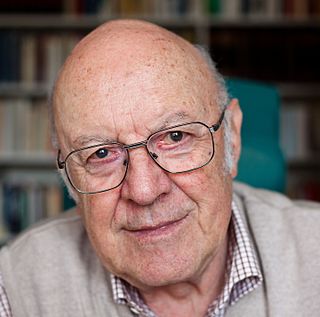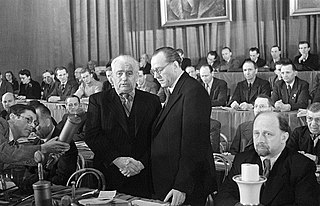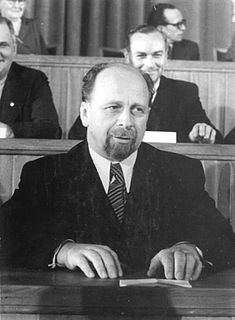 W
WThomas Ammer is a German historian who as a young man studied to become a physician. He was arrested and imprisoned in 1958 for anti-government political activism in East Germany and he never qualified as a medical doctor. His 15-year prison sentence was cut short in August 1964 when his release was purchased by the West German government, and at the age of 27 he relocated to the German Federal Republic.
 W
WThe Chamber of States was the upper chamber of the bicameral legislature of the German Democratic Republic from its founding in 1949 until 1952, at which time it was largely sidelined, when the five Länder (states) of East Germany ceased to exist and were replaced with smaller administrative regions. The Chamber of States itself was dissolved on 8 December 1958. The lower chamber, which continued in existence until German reunification in 1990, was the People's Chamber (Volkskammer).
 W
WRound table primarily refers to the Central Round Table, a series of meetings during the Peaceful Revolution in East Germany in late-1989 and early-1990.
 W
WThe Exil-CDU was from 1950 to 1990 a national federation of the CDU. It represented CDU members who had escaped or expelled from the Soviet occupation zone or GDR.
 W
WKarl Wilhelm Fricke is a German political journalist and author. He has produced several of the standard works on resistance and state repression in the German Democratic Republic (1949–1990). In 1955 he became one of several hundred kidnap victims of the East German Ministry for State Security, captured in West Berlin and taken to the east where for nearly five years he was held in state detention.
 W
WThe German Economic Commission was the top administrative body in the Soviet Occupation Zone of Germany prior to the creation of the German Democratic Republic.
 W
WWalter Janka was a German communist, political activist and writer who became a publisher.
 W
WThe political leadership of East Germany was in the hands of several offices.
 W
WThe Federal Minister for Foreign Affairs is the head of the Federal Foreign Office and a member of the Cabinet of Germany. The current office holder is Heiko Maas. Since 1966, the Foreign Minister has often also simultaneously held the office of Vice Chancellor.
 W
WThis article lists the leaders of administrative divisions of East Germany, officially the German Democratic Republic. GDR was a country that existed from 1949 to 1990, when the eastern portion of Germany was part of the Eastern Bloc during the Cold War.
 W
WThe Volkskammer was the unicameral legislature of the German Democratic Republic.
 W
WThe Communist Party of Germany (KPD) and the Social Democratic Party of Germany (SPD) merged to form the Socialist Unity Party of Germany (SED) on 21 April 1946 in the territory of the Soviet occupation zone. It is considered a forced merger. In the course of the merger, about 5,000 Social Democrats who opposed it were detained and sent to labour camps and jails.
 W
WThe National Committee for a Free Germany was a German anti-Nazi organization that operated in the Soviet Union during World War II.
 W
WThe Olof Palme Peace March was a transnational peace march/demonstration that took place in the German Democratic Republic during September 1987.
 W
WThe Soviet Control Commission was a monitoring and management committee established by the Soviet Union in order to oversee the leadership of the German Democratic Republic. It was active from 10 October 1949 and 20 September 1955 and it was legitimated by the Potsdam Agreement between the Allies.
 W
WThe Ulbricht Group was a group of exiled members of the Communist Party of Germany, led by Walter Ulbricht, who flew from the Soviet Union back to Germany on April 30, 1945. Composed of functionaries from the KPD and ten anti-fascist prisoners of war, their job was to seek out anti-fascist individuals and prepare the groundwork for the re-establishment of communist organizations and unions in postwar Berlin. There were two additional regional groups, the Ackermann Group in Saxony and the Sobottka Group in Mecklenburg. Many of the group's members later became high-level officials in the government of the German Democratic Republic (GDR).
 W
WWaldsiedlung was the secure housing zone for the leaders of the German Democratic Republic in Bernau bei Berlin, Brandenburg from 1960 to 1989. Waldsiedlung housed the most senior party members of the ruling Socialist Unity Party of Germany in relative luxury near Wandlitz, 30 kilometres (19 mi) north of East Berlin, with surrounding areas off-limits to all ordinary citizens.